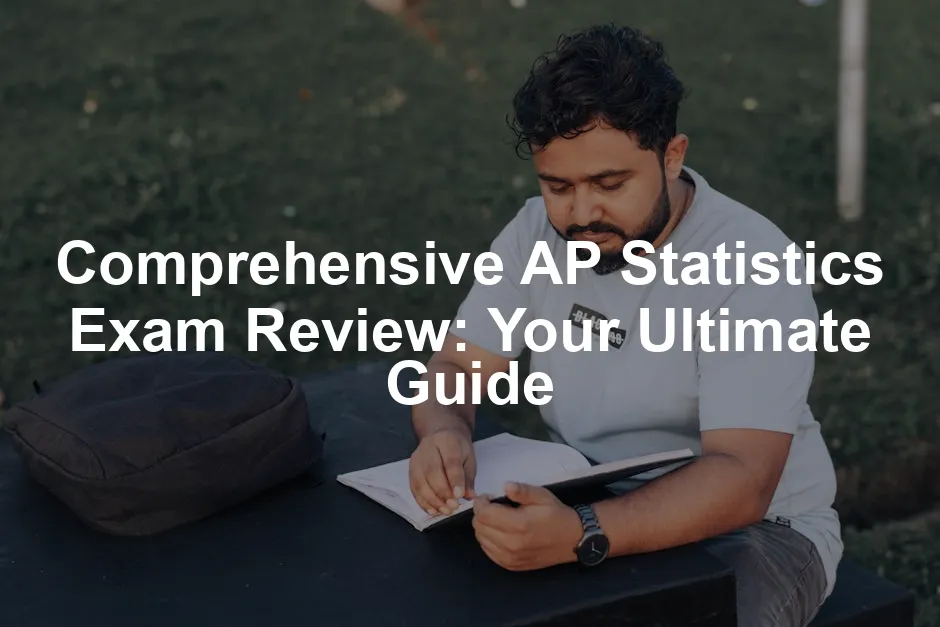Introduction
The AP Statistics exam is more than just another standardized test; it’s a stepping stone towards college success. High school students who ace this exam can earn college credit, saving both time and money. Plus, it helps develop analytical skills essential for various fields, from psychology to economics.
This guide is crafted to help you prepare effectively for the AP Statistics exam. Here, you will find practical tips, exam structure, study strategies, and resources that’ll boost your confidence. By the end, you’ll be well-equipped to tackle the test head-on.
The article is structured into sections, starting with an overview of the exam itself. You’ll learn about its format, scoring, and the benefits of taking it. Next, we delve into the key topics covered on the exam, followed by strategies to approach different question types. Finally, we’ll share effective study strategies to help you maximize your preparation. So, grab your calculator and let’s get started!

1. AP Statistics Exam Overview
1.1 What is the AP Statistics Exam?
The AP Statistics exam is a standardized test administered by the College Board. It evaluates students’ understanding of statistical concepts and methods. The purpose? To assess whether students are ready for college-level coursework in statistics.
Taking this exam comes with a wealth of benefits. First, students can potentially earn college credit, depending on their score and the policies of their chosen institutions. Secondly, it enhances critical thinking and data analysis skills, which are invaluable in today’s data-driven world. And let’s not forget the bragging rights! Scoring well can boost your college applications, making you stand out among peers.
To sharpen your skills, consider checking out The Practice of Statistics by Daren Starnes. This book is a treasure trove of information, offering clear explanations and practice problems that will make you feel like a statistics wizard!

1.2 Exam Structure and Format
The AP Statistics exam lasts a total of three hours, split into two main sections.
- Section I: Multiple Choice consists of 40 questions that you’ll need to complete in 90 minutes. This section accounts for 50% of your overall score.
- Section II: Free Response includes six questions with a 90-minute time limit. It’s split further into Part A—five free-response questions completed in 60 minutes—and Part B—one investigative task question, which takes 30 minutes. This section also weighs in at 50% of your total score.
Understanding this structure is crucial. It helps you allocate your time wisely during the exam, ensuring you tackle each question with the attention it deserves.
1.3 Scoring and College Credit
The AP Statistics scoring scale ranges from 1 to 5. A score of 1 indicates no recommendation, while a score of 5 signifies you are extremely qualified. Most colleges typically grant credit for scores of 3 and above, but the exact policies vary by institution.
For example, based on the distribution of scores from May 2022, about 37% of students scored a 3 or higher. This means that while the exam is challenging, many students do succeed. Understanding this scoring system can motivate you to aim high and focus on mastering the material.
In conclusion, preparing for the AP Statistics exam is not just about passing; it’s about developing skills that will serve you well in college and beyond. So, let’s gear up and dive into the topics that will help you ace this test!

2. Topics Covered on the AP Statistics Exam
2.1 Key Units and Content Areas
The AP Statistics exam is like a buffet of statistical delights, serving up a diverse range of topics. The College Board outlines nine key units, each crucial for mastering the art of statistics. Let’s take a bite out of each unit:
- Exploring One-Variable Data: In this unit, you’ll learn how to describe and analyze data that revolves around a single variable. Expect to encounter various graphical displays such as histograms and dot plots. Understanding measures of central tendency like the mean and median will be your bread and butter.
- Exploring Two-Variable Data: Here, we kick things up a notch. You’ll explore the relationship between two variables. Get ready to investigate scatterplots, correlation, and regression. You’ll become a pro at determining how one variable affects another—think of it as a statistical matchmaking service!
- Collecting Data: This unit focuses on how to gather statistics responsibly. You’ll learn about sampling methods and experimental design. A well-designed survey is like a well-cooked meal: it requires the right ingredients and techniques to yield tasty results.
- Probability, Random Variables, and Probability Distributions: Brace yourself for the wild world of chance! This unit delves into the intricacies of probability, random variables, and their distributions. You’ll tackle concepts like the binomial distribution, which helps you understand scenarios with two outcomes—like flipping a coin.
- Sampling Distributions: Ever wondered how sample size affects your results? This unit answers that burning question. You’ll learn about the Central Limit Theorem and how sampling distributions allow us to make inferences about entire populations from just a sample.
- Inference for Categorical Data: Proportions: In this unit, you’ll focus on making inferences about population proportions. Get ready to craft confidence intervals and conduct hypothesis tests. It’s all about determining whether your sample data holds water when compared to the larger population.
- Inference for Quantitative Data: Means: Time to turn your attention back to means! This unit is all about making inferences regarding population means. You’ll explore confidence intervals and significance tests that help you draw conclusions from numerical data.
- Inference for Categorical Data: Chi-Square: The chi-square test is your go-to for categorical data analysis. This unit will teach you how to assess goodness of fit and independence. Who knew that a simple comparison could reveal such important insights?
- Inference for Quantitative Data: Slopes: Lastly, we dive into regression analysis. Here, you’ll investigate the relationship between two quantitative variables. From calculating slopes to crafting linear models, this unit will have you predicting outcomes like a fortune teller.

2.2 Detailed Unit Breakdown
Now that we’ve whetted our appetite, let’s break down each unit with specific topics and potential exam questions.
- Unit 1 (One-Variable Data): Understand the various ways to summarize data. A typical question might ask you to interpret a histogram and identify the mean and standard deviation.
- Unit 2 (Two-Variable Data): Be prepared for questions on correlation coefficients and regression lines. You might be asked to determine the strength of a relationship based on a scatterplot.
- Unit 3 (Collecting Data): Questions could revolve around different sampling methods. For example, you may need to identify which method is best for a particular study.
- Unit 4 (Probability): Expect scenario-based questions testing your grasp of probability rules. You might need to calculate the probability of certain outcomes in a given situation.
- Unit 5 (Sampling Distributions): This unit often features questions about the Central Limit Theorem. You could be asked how increasing sample size affects the distribution of sample means.
- Unit 6 (Inference for Proportions): Questions could ask you to calculate a confidence interval for a population proportion based on sample data.
- Unit 7 (Inference for Means): You might be tasked with performing a hypothesis test for a population mean. Knowing how to set up the null and alternative hypotheses is critical.
- Unit 8 (Chi-Square): Look out for questions requiring you to perform chi-square tests. You may need to determine if observed frequencies differ from expected frequencies.
- Unit 9 (Slopes): Questions could involve interpreting the slope of a regression line. You might need to explain what a positive or negative slope indicates about the relationship between variables.

2.3 AP Statistics Formula Sheet
Ah, the magical formula sheet! During the exam, you’ll receive a formula sheet packed with essential equations and distributions. It’s your best friend when things get tricky.
Use the formula sheet wisely. Familiarize yourself with it before the exam, so you know where to find what you need quickly. Remember, time is of the essence!
Tips for using the formula sheet:
- Don’t hesitate to glance at it during practice exams to get comfortable.
- Highlight or annotate key formulas that you find particularly helpful.
In conclusion, mastering these units and understanding their significance will prepare you for success on the AP Statistics exam. With a solid grasp of the content areas and strategic use of the formula sheet, you’ll be well on your way to acing the test. So, roll up those sleeves and get ready for some serious statistical fun!

3. Question Types and Exam Strategies
3.1 Understanding Question Types
The AP Statistics exam is a delightful mix of question types that test your statistical prowess. Let’s break it down!
Multiple-Choice Questions: These are your quick-fire rounds. You’ll tackle 40 multiple-choice questions in 90 minutes. Each question has one correct answer out of four options. These questions assess everything from your understanding of key concepts to your ability to interpret data displays. You’ll find questions on one-variable and two-variable data, probability, and statistical inference.
Free-Response Questions: This section is where you can really show off your statistical skills. The free-response section consists of six questions. The first five focus on specific statistical concepts, while the last question is an investigative task. This task requires you to apply multiple statistical concepts to a real-world scenario, showcasing your analytical skills. Clarity and justification in your responses are key!

3.2 Tips for Multiple-Choice Questions
Navigating the multiple-choice section can feel like walking a tightrope. Here are some strategies to keep your balance:
- Read Carefully: Pay attention to the wording. Sometimes, questions may have tricky phrasing that can lead you astray.
- Eliminate Wrong Answers: If you’re unsure, eliminate the obviously incorrect choices first. This increases your odds if you need to guess.
- Pace Yourself: Don’t spend too long on any one question. If you’re stuck, move on and come back if time allows.
- Practice with Past Papers: Familiarize yourself with the style and format of multiple-choice questions. Practice makes perfect!
Common pitfalls include misreading questions or falling for distractors, which are designed to lead you off track. Stay sharp and focused to avoid these traps!

3.3 Approaching Free-Response Questions
Free-response questions can seem daunting, but with the right approach, you can conquer them.
- Structure Your Answers: Start with a clear introduction that outlines your approach. Follow with the main body where you present your calculations and reasoning, and finish with a concise conclusion summarizing your findings.
- Show Your Work: Don’t just provide answers; show how you arrived at them. This will earn you valuable points even if your final answer is incorrect.
- Use Statistical Language: Communicate your reasoning using proper terminology. Phrases like “The confidence interval suggests…” or “The hypothesis test indicates…” can impress the graders.
- Justify Your Answers: Explain why your answer is correct. This demonstrates a deeper understanding of the concepts and can help you score higher.
Remember, clarity is essential! The last thing you want is for your brilliant answer to be lost in a fog of jargon.

3.4 Calculator Use and Policy
Now, let’s talk about one of the best friends a statistics student can have—your calculator!
Calculator Policy: You’re allowed to use a scientific or graphing calculator during both sections of the exam. However, make sure it’s a model that can handle statistical calculations. Be sure to check the College Board’s guidelines on approved calculators to avoid any surprises on exam day.
- Graphing Calculators: Models like the TI-84 Plus CE Graphing Calculator or the TI-Nspire CX II Graphing Calculator are popular choices. They can handle a variety of functions, from regression analysis to creating plots.
- Know Your Calculator’s Functions: Familiarize yourself with its statistical capabilities. Practice using it to calculate means, standard deviations, and perform hypothesis tests. The better you know your calculator, the quicker you can solve problems during the exam.
- Keep It Charged: Don’t forget to charge your calculator the night before! Running out of battery mid-exam is a nightmare no student wants to face.
In conclusion, understanding the question types and employing effective strategies can significantly enhance your performance on the AP Statistics exam. Equip yourself with knowledge, practice diligently, and you’ll be ready to tackle those questions like a pro!

4. Effective Study Strategies and Resources
4.1 Creating a Study Plan
Crafting a study plan isn’t just smart; it’s essential. With the AP Statistics exam looming, a personalized study schedule can be your secret weapon. Start by assessing how much time you have until the exam. Break that time down into manageable chunks.
Set aside dedicated study blocks. Aim for 1-2 hours of focused study each day. Mix in short breaks to keep your mind fresh. Use a calendar or planner to map out your study sessions. This visual representation helps you stay accountable.
Realistic goals are key. If you say, “I’ll master every unit in a week,” you’re setting yourself up for disappointment. Instead, focus on one unit at a time. For example, dedicate a week to Exploring One-Variable Data. Within that week, set daily goals like understanding measures of central tendency on Monday and practicing histogram interpretations on Tuesday.
Don’t forget to include review days! After a few weeks of studying, schedule time to revisit what you’ve learned. This repetition reinforces your knowledge.
Lastly, keep it flexible. Life happens, and sometimes you might need to adjust your plan. Stay adaptable, and don’t beat yourself up if you miss a study session. Just get back on track!

4.2 Recommended Study Materials and Resources
When it comes to prepping for the AP Statistics exam, having the right resources is crucial. Start with a solid textbook. “The Practice of Statistics” by Daren Starnes is a fan favorite. It offers clear explanations and plenty of practice problems.
Online resources are a treasure trove of information. Websites like Khan Academy provide free lessons and practice questions tailored to AP Statistics. YouTube channels like Stats Medic offer engaging video tutorials that break down complex concepts.
Don’t overlook practice exams! They mimic the actual test format, helping you get comfortable with the timing and question types. The College Board website has released past exams, which are invaluable for practice.
Consider investing in a review book. The Princeton Review AP Statistics Prep, 2023 and Barron’s AP Statistics, 2023 both offer comprehensive guides filled with strategies and practice questions. These guides often include tips specifically tailored for the exam format.

Finally, don’t shy away from study packets. The Ultimate Review Packet for AP Statistics is a fantastic resource, providing strategies, tips, and practice questions specifically designed for the exam.
4.3 Practice Exams and Reviews
Practice exams are your best friend as the exam date approaches. Taking full-length practice exams simulates the real test experience. This not only boosts confidence but also helps you manage time effectively.
After each practice exam, analyze your performance. Look for patterns in your mistakes. Did you struggle with multiple-choice questions on probability? Or was it the free-response section that tripped you up? Identifying weak areas allows you to focus your study efforts.
Use the grading rubrics provided by the College Board to evaluate your free-response answers. This will give you insight into how your responses align with what the examiners are looking for.
Additionally, consider doing practice questions with a study group. Discussing questions and explaining your thought process enhances understanding. Teaching others is a powerful way to reinforce your own knowledge.

4.4 Last-Minute Review Strategies
As the exam approaches, you might feel the pressure rising. Fear not! Last-minute review strategies can help reinforce your knowledge without causing panic.
Start by creating a condensed study guide. Summarize key formulas, concepts, and strategies on one sheet. This cheat sheet can be a quick reference for the final days before the exam.
Focus on high-yield topics. Review essential concepts that are heavily tested, such as hypothesis testing and confidence intervals.
In the last few days, practice relaxation techniques. Stress can cloud your mind, so try deep breathing exercises or light yoga. On the day before the exam, don’t cram! Instead, take a break. Engage in a relaxing activity, like reading or watching a movie.
Ensure you’re mentally prepared by getting plenty of sleep. A well-rested mind performs better.
On exam day, arrive early with all necessary materials, including your calculator and ID. Take a moment to breathe and stay positive. You’ve prepared, and you’re ready to tackle this challenge!

5. Test Day Preparation
5.1 What to Bring on Exam Day
Preparing for the AP Statistics exam doesn’t stop at studying. It’s time to pack your bag and ensure you’re equipped for the big day! Here’s a handy checklist of items to bring along:
- No. 2 Pencils: Bring several sharpened pencils. You wouldn’t want to be the one frantically looking for a pencil while the clock is ticking! You can grab a pack of No. 2 Pencils (Pack of 12) to ensure you’re ready!
- Black or Dark Blue Pens: Perfect for those free-response questions. Avoid bright colors—this isn’t a coloring book. A Pack of 12 Black or Dark Blue Pens will do the trick!
- Calculator: A graphing calculator with statistical functions is a must. Make sure it’s charged! You don’t want to be left in a lurch.
- Valid Photo ID: This could be a school ID or any government-issued ID. You need to prove you are who you say you are!
- Water Bottle: Staying hydrated helps you think clearly. But remember, no food allowed in the exam room. You might want to consider a Water Bottle with Time Marker to keep track of hydration!
- Watch: A simple watch (not a smart one!) will help you manage your time. Keep track without getting distracted by notifications. Opt for a Simple Analog Watch for this purpose!
- Testing Confirmation: Bring your exam admission ticket or any confirmation email. It’s your golden ticket to the test!
- Extra Supplies: It doesn’t hurt to have a backup pencil or two. Better safe than sorry!

To ensure you’re not scrambling last minute, prepare these materials the night before. Lay everything out, double-check your calculator’s battery, and pack your bag with care. You’ll thank yourself for it later!
5.2 Test Day Tips
The day of the AP Statistics exam can feel like a roller coaster—exciting yet nerve-wracking. Here are some strategies to help you manage your time and maintain your cool:
- Time Management Strategies:
- Familiarize Yourself with the Structure: Know how much time you have for each section. You’ll get 90 minutes for the multiple-choice section and 90 minutes for the free-response section. Keep an eye on the clock!
- Set a Pace: For the multiple-choice questions, aim to spend about 2 minutes on each question. If you’re stuck, mark it and move on. You can always come back if time permits.
- Prioritize the Easy Questions: Start with questions that you find easier. This builds confidence and ensures you score those points before tackling the tougher ones.
- Allocate Time for the Free Response: Spend about 65 minutes on the first five free-response questions and 25 minutes on the investigative task. This ensures you give each part the attention it deserves.
- Staying Calm and Focused:
- Breathe: If anxiety creeps in, take a few deep breaths. Inhale through your nose, hold it for a moment, and exhale slowly. You got this!
- Stay Positive: Replace negative thoughts with affirmations. Remind yourself of the hard work you’ve put in. Confidence is key!
- Avoid Distractions: Stay focused on your exam. Don’t glance around or compare your pace with others. Everyone has their own journey.
- Take Breaks: If you feel overwhelmed, take a mental break. Close your eyes for a moment, stretch your legs, and reset your mind before diving back in.
Remember, test day is just one day. It doesn’t define your entire future. Approach it with a clear head, and know that you’re ready to tackle whatever comes your way!
FAQs
For a deeper understanding of the materials, check out an introduction to statistical learning with python book length.
What is the best way to study for the AP Statistics exam?
The best approach includes creating a study plan, utilizing practice exams, and reinforcing concepts through various resources. Break topics into manageable parts and ensure consistent review.
How can I improve my scores on free-response questions?
Focus on structuring your answers clearly, showing all work, and justifying your reasoning. Practice with released AP questions to familiarize yourself with the format and scoring rubrics.
What resources are available for additional practice?
Websites like Khan Academy and Albert.io offer free practice questions and video lessons. Additionally, review books such as those from The Princeton Review or Barron’s are excellent resources.
Is it worth taking the AP Statistics exam?
Absolutely! Scoring well can earn you college credit, enhance your college applications, and provide you with valuable skills in data analysis and critical thinking.
What should I do if I feel overwhelmed before the exam?
Take deep breaths, engage in relaxation techniques, and focus on positive affirmations. Remind yourself of the preparation you’ve done. Avoid cramming the night before to keep your mind clear.
Please let us know what you think about our content by leaving a comment down below!
Thank you for reading till here 🙂
All images from Pexels




